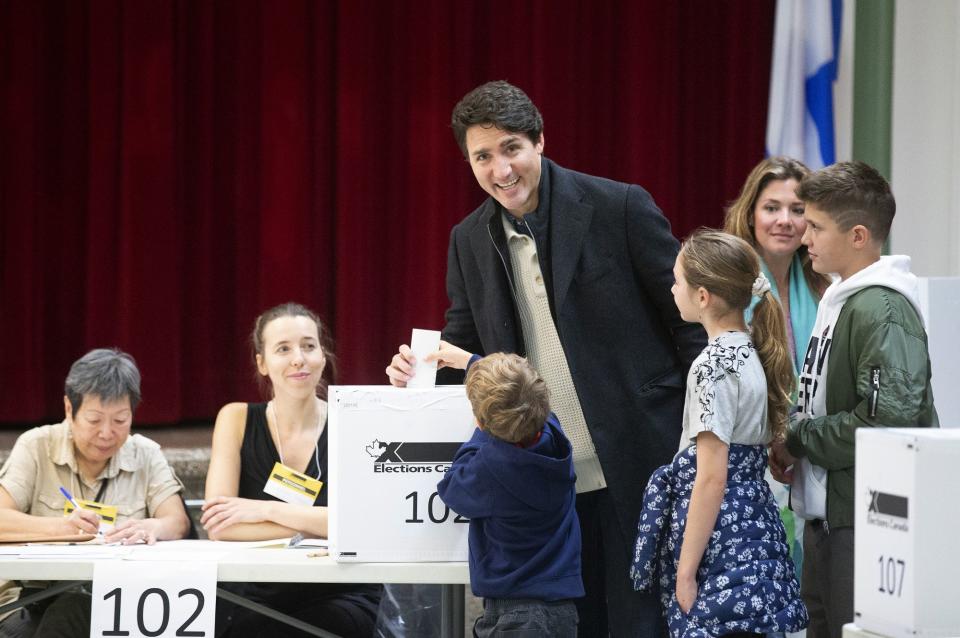Liberal-NDP Tally Exceeds 170 Seats: Canada Election Update

(Bloomberg) -- The combined tally of Justin Trudeau’s Liberals and the left-leaning New Democratic Party has climbed above 170 seats, potentially giving the prime minister an ally as he seeks to remain in power with a minority government.
The Liberals were elected or leading in 152 of Canada’s 338 districts, according to preliminary results from Elections Canada and the Canadian Broadcasting Corp. The NDP, led by Jagmeet Singh, were sitting at 24, for a combined 176 districts. Andrew Scheer’s Conservatives, who pre-election polls showed were running neck and neck with the Liberals, had 120 districts.
That said, preliminary returns showed the Conservatives had captured 33.9% of the popular vote, versus 33.8% for the Liberals.
Trudeau Poised to Win Second Term, Fall Short of Majority (10:30 p.m.)
Canadian Prime Minister Justin Trudeau is poised to win a second term in national elections, winning enough seats to form a minority government.
The ruling Liberals were elected or leading in 150 districts, ahead of the 100 for the Andrew Scheer’s Conservatives, according to projections from the Canadian Broadcasting Corp. The parties need 170 seats to form a majority in the House of Commons.
Trudeau extends lead as polls close across country (10:03 p.m)
As results from Canada’s largest provinces begin to pour in, Justin Trudeau’s Liberal Party is holding its lead over Andrew Scheer’s Conservatives.
The Liberals are elected or leading in 113 of Canada’s 338 districts, the Conservatives in 79, according to preliminary results from Elections Canada and the Canadian Broadcasting Corp. The separatist Bloc Quebecois was sitting in third place with 18, followed by the New Democratic Party with nine. If no party wins the 170 districts required for a majority, the winner would require the support of one of the smaller parties to remain in power.
British Columbia polls closed at 10 p.m. eastern time.
Trudeau In Lead as Most Polls Close (9:30 p.m.)
Justin Trudeau’s ruling Liberal Party was on track to hang on to most of its seats in Atlantic Canada, as the next wave of results from Canada’s tight election were set to come in from Quebec all the way to Alberta in the west.
With polls now closed in another 262 of the 338 districts, the Liberals won or were leading in 24 of 32 districts in the Eastern provinces, according to preliminary results from Elections Canada and the Canadian Broadcasting Corp. The Conservatives were ahead in six districts, while the New Democrats and the Green Party won or were leading in one each.
Trudeau Posts Expected Atlantic Losses (8 p.m.)
Justin Trudeau’s ruling Liberal Party was on track to lose roughly half a dozen seats in Atlantic Canada, as expected, as results began to roll in for what is poised to be one of the closest elections in the country’s history.
The Liberals have won or were leading in 24 of 32 districts, according to preliminary results from Elections Canada and the Canadian Broadcasting Corp. The Conservatives were ahead in six districts, known as ridings, while the New Democrats were leading in one. In 2015, the Liberals swept the region, which accounts for less than 10% of the 338 up for grabs in the federal election. Trudeau was widely expected to retain most of his seats there while losing some from the 2015 results.
Trudeau is seeking a second term as prime minister -- weighed down by scandal and voter fatigue but still poised to win more districts than any of his rivals, based on polling projections at the end of the campaign. Trudeau and Conservative Leader Andrew Scheer were tied in popular support for much of the final week, though Trudeau’s support is spread more widely and in vote-rich regions like Ontario and Quebec.
No party looks poised to win 170 districts required for a majority, meaning the winner will likely require the support of other parties to pass laws. As the incumbent, Trudeau has the right to continue to govern and test parliament for support, even if he wins fewer districts than Scheer.
If Trudeau tries to govern with or without a plurality, it will likely force a leftward shift in his agenda. His most natural partner is the New Democratic Party, which is anti-pipeline, and wants more aggressive moves to combat climate change, higher taxes for companies and the wealthy, and the creation of new universal social programs.
A Liberal government propped up by the NDP wouldn’t be an ideal scenario for Canada’s energy sector, already saddled with reduced oil prices due to pipeline bottlenecks. The prospect of that loose alliance may also send the Canadian dollar lower.
There are many wild cards, including voter turnout, the strength of the separatist Bloc Quebecois, and whether Toronto’s vote-rich suburbs will break Trudeau’s way. The biggest question mark may lie on the West Coast. British Columbia, Canada’s third-most-populous province, looks like a dead heat among the Liberals, Conservatives and the NDP.
To contact the reporter on this story: Josh Wingrove in Washington at jwingrove4@bloomberg.net
To contact the editors responsible for this story: David Scanlan at dscanlan@bloomberg.net, Stephen Wicary
For more articles like this, please visit us at bloomberg.com
©2019 Bloomberg L.P.

